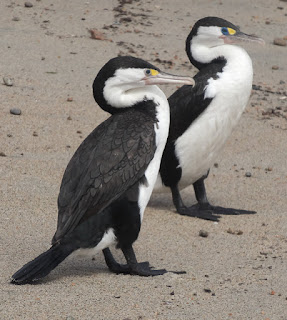It's hard to believe our 2-month journey is coming to an end. We had a grand finale in Kaikoura over the past few days. We did our first Whale Watch ever. There is a deep 4000-foot canyon off the coast where cold water from Antarctica and warm water from the Pacific mix causing an upwelling. This brings food up from the depths and attracts the whales. We were looking for Sperm Whales, the largest of the toothed whales and the world's largest predator. Mature males can weigh up to 63 tons and grow as long as 67 feet! They can live up to 60-70 years. So, where did the name Sperm Whale come from? The early whalers found a semi-liquid, waxy substance coming out
of the head of male sperm whales. They made the assumption that it was sperm and that the whale's reproductive organs must be in it's massive head. However when they found the same substance in a female they knew they had been mistaken. The name had already caught on so Sperm Whale it is. The substance is actually spermaceti and it is believed to aid in echolocation and buoyancy. The captain used a hydrophone to pick up clicks from the whales then would move to the general location. At last, a sperm whale on the surface!
You can see very little of the whale except for the dorsal fin and the blowhole through which carbon dioxide is expelled in a spray of water. If you could see the whole whale he would look like this (not our picture):
The gray skin of the whale was wrinkled like an elephant's hide. They don't stay on the surface for more than ten minutes. Once their oxygen is replenished they will dive again displaying their massive tails.
Sperm whales can dive to 9700 feet making it the deepest diving mammal and stay submerged for 90 minutes! Their favorite prey is colossal and giant squid. It's clicking vocalization, a form of echolocation and communication, can be as loud as 230 decibels, making it the loudest sound produced by an animal. The male we saw in the photos above is a migrant whale. The captain did locate a second whale which is a resident whale named Aoraki. The waters here are too cold for female sperm whales. The males actually have more fat than the females. All too soon it was time to return to shore.
Later in the day we went to visit a New Zealand Fur Seal colony. We sat on rocks above the group and watched the pups play "king of the rock", tug of war with a piece of kelp, frolic in the water and push each other around like Sumo wrestlers.
The adults napped on the rocks, keeping one eye open on the pups. One handsome fellow posed nicely for Marc.
We had the rare privilege of swimming with Dusky Dolphins. I wasn't sure if I'd get up the nerve to enter the water but once I saw the dolphins and with a flotation device, I slipped carefully into the water.
The initial shock of the 64 degree water made it hard to breath. I soon relaxed as I saw my first Dusky Dolphins glide below me. What beautiful graceful creatures they are! I made noises through my snorkel to attract them. I'm not sure if it worked but more dolphins did swim past and below me. After swimming with the dolphins we had a photo shoot. The captain brought us along a huge pod of dolphins, maybe 200-300! The dusky dolphin (Lagenorhynchus obscurus) is commonly found along the east coast of the South Island of New Zealand. They can grow up to six and a half feet in length and weigh as much as 200 pounds. Dusky dolphins can live up to 20 to 25 years. The dolphins were really putting on a show with their spectacular leaps, jumps, side slaps, back flips and somersaults. Marc was able to catch some of their amazing acrobatics.
Lastly we went on an Albatross tour. I wasn't quite sure what to expect but was somewhat surprised when our guide threw a basket of chum off the back of the boat to attract the birds. It didn't
take long for the Wandering Albatross, Northern Giant Petrels and Cape Petrels to show up. I must admit it was a great way to get a close look at the birds. We noticed a pink color on the necks of some of the Wandering Albatrosses that we had not seen before.
Gibson's Wandering Albatross
Our guide told us that it was believed to be breeding plumage or bacteria growing on salt deposits that the Albatross excretes from it's nostrils. We also got a good look at a Salvin and Northern Royal Albatross, two new species for us.
Salvin's Albatross
Northern Royal Albatross
When flying, all albatrosses looked similar to me. When viewed up close you can really see the difference in size, bill coloration and plumage. Near the end of the tour, Tracy, our guide dumped the remainder of the chum into the water creating quite a feeding frenzy.
We're in the San Francisco Airport waiting for our flight to Chicago. We will arrive on Thursday morning after spending the night in Chicago. We look forward to catching up with everyone.
Peggy and Marc


























































